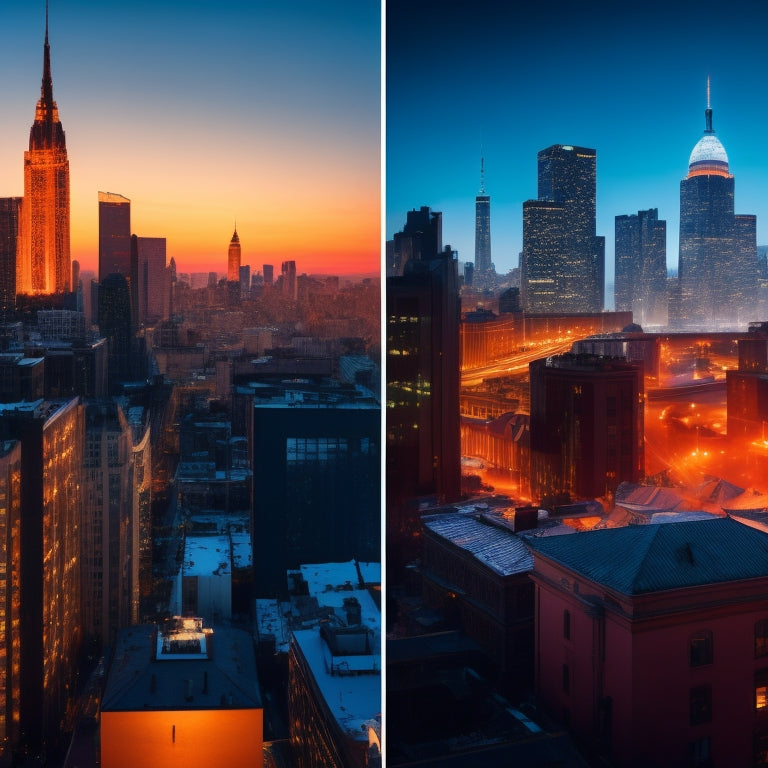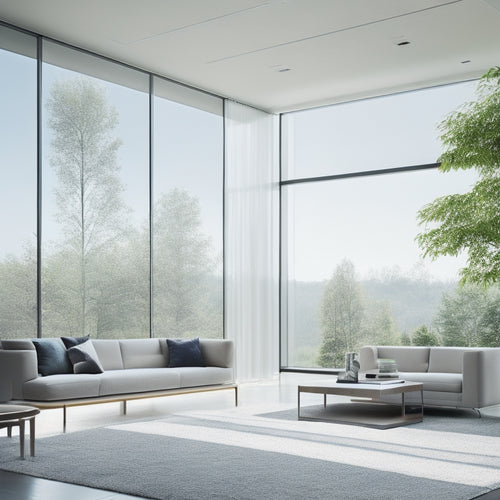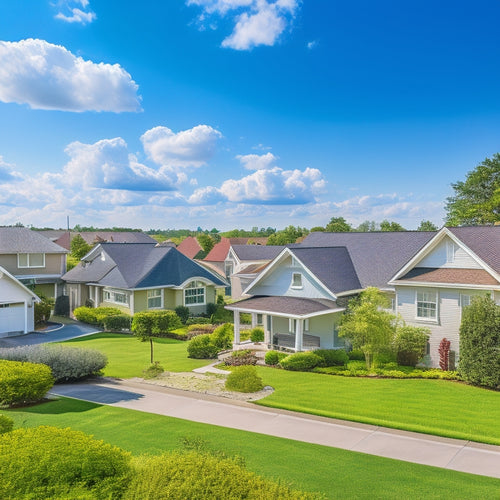
What Are Cool Roofs' Impact on Urban Heat?
Share
When you adopt cool roofs, you can expect a significant decline in urban temperatures. By utilizing materials with high solar reflectance and thermal emittance, cool roofs reduce heat absorption in buildings, leading to energy savings of 10-30% compared to traditional roofs. This mitigation strategy tackles the urban heat island effect, which currently plagues 90% of urban roofs that absorb most solar radiation. By implementing cool roofs, you'll not only conserve energy but also improve air quality by reducing particulate matter and volatile organic compounds. As you investigate further, you'll uncover more understandings into the impact of cool roofs on urban heat and the paths to a more sustainable future.
Key Takeaways
- Cool roofs reduce urban heat island effect by decreasing heat absorption in buildings, leading to energy savings and air quality improvement.
- High-albedo roofs (> 0.5) effectively reflect solar radiation, mitigating urban heat islands, while very high-albedo roofs (> 0.8) can cool surrounding environments.
- Cool roofs can lead to energy savings of 10-30% compared to traditional roofs, with specific savings reported in various cities like New York City and Los Angeles.
- By reducing heat absorption, cool roofs decrease the formation of particulate matter and volatile organic compounds, improving air quality and respiratory health.
- Widespread adoption of cool roofs can contribute to urban sustainability, reducing the urban heat island effect and its associated health risks and environmental consequences.
Urban Heat Island Effect Explained
As you maneuver through urban environments, you're likely to notice a peculiar phenomenon: cities tend to be warmer than their surrounding rural areas. This temperature difference is known as the urban heat island effect.
It occurs when built-up areas absorb and retain heat from the sun, releasing it back into the environment at night. Urban climate is characterized by heat absorption, mainly due to the high concentration of heat-absorbing surfaces like pavement, buildings, and vehicles.
In addition, the integration of renewable energy sources can mitigate the urban heat island effect by reducing the reliance on non-renewable energy sources, which contribute to the problem.
Moreover, incorporating green infrastructure, such as solar panels, can also help to decrease the urban heat island effect.
Understanding the urban heat island effect is vital for developing strategies to mitigate its impact on urban dwellers and the environment.
Cool Roofs as a Mitigation Strategy
You've seen how the urban heat island effect can intensify the temperature in cities, making them uncomfortably warm.
Now, let's investigate how cool roofs can be an effective mitigation strategy. Implementing cool roof technologies can markedly reduce the urban heat island effect. These technologies involve using roofing materials with high solar reflectance and thermal emittance, which help reflect sunlight and heat away from buildings.
In addition, adopting renewable energy solutions, such as solar panels, can also contribute to a cleaner and more sustainable urban environment. By doing so, they can reduce the amount of heat absorbed by buildings, thereby decreasing the urban heat island effect.
Community engagement is essential in promoting the adoption of cool roofs, as it raises awareness about the benefits and encourages collective action.
Reflective Roofing Materials Matter
Nearly 90% of roofs in urban areas are dark-colored, which means they absorb most of the sun's radiation, contributing considerably to the urban heat island effect.
You can make a significant difference by choosing reflective roofing materials that reduce heat absorption. Additionally, incorporating eco-friendly stops with solar canopies and rainwater systems sustainable road trip amenities can further enhance urban aesthetics.
These materials, such as reflective coatings, have high solar reflectance values, ensuring they reflect a significant amount of solar radiation. This leads to improved thermal performance, energy efficiency, and material durability.
Additionally, you can opt for advanced roofing technologies that incorporate installation methods suitable for various climates. By selecting materials that adapt to local conditions, you'll enhance urban aesthetics while reducing the urban heat island effect.
Policy incentives and market trends are shifting towards these innovative solutions, making them more accessible than ever.
Urban Heat Island Consequences
Urban heat islands drive up energy consumption, air pollution, and mortality rates, imposing significant economic and public health burdens on cities.
You're likely familiar with the sweltering heat that settles over urban areas during the summer months, but you may not realize the full extent of its consequences.
By incorporating solar-powered charging solutions, cities can reduce their reliance on traditional power sources and lower their carbon footprint.
Heat stress, a major concern, can exacerbate existing health conditions, particularly for vulnerable populations like the elderly and young children.
As cities struggle to maintain urban sustainability, heat islands pose a significant obstacle.
By understanding the far-reaching implications of urban heat islands, you can better appreciate the importance of mitigating their effects.
It's essential to address this issue to guarantee a healthier, more sustainable future for urban dwellers.
Energy Savings With Cool Roofs
As cities strive to reduce their energy consumption and mitigate the urban heat island effect, cool roofs emerge as a promising solution. By installing cool roofs, you can greatly reduce the energy needed to cool your building, leading to substantial cost savings. According to studies, cool roofs can provide an average energy savings of 10-30% compared to traditional roofs.
| Location | Energy Savings | Cost Benefits |
|---|---|---|
| New York City | 15-20% | $0.05-0.10/kWh |
| Los Angeles | 20-25% | $0.10-0.20/kWh |
| Chicago | 10-15% | $0.03-0.08/kWh |
| Houston | 25-30% | $0.15-0.30/kWh |
These savings can add up quickly, providing a considerable return on investment for building owners and managers. By choosing a cool roof, you're not only reducing your energy consumption but also contributing to a more energy-efficient and sustainable urban environment.
Cool Roofs and Air Quality
You'll find that cool roofs have a significant impact on air quality, contributing to cleaner city air by reducing the concentration of particulate matter and volatile organic compounds.
As the world shifts towards a low-carbon economy sustainable energy outlook, cool roofs play an essential role in mitigating the urban heat island effect, which is exacerbated by the projected 70% urban population growth by 2050.
By decreasing the formation of smog, cool roofs can minimize the negative impacts of urban air pollution on human health.
In urban areas, cool roofs can even help reduce ozone levels, which is vital since ozone exacerbates respiratory issues like asthma.
Cleaner City Air
City dwellers inhale a toxic cocktail of pollutants, including particulate matter, ozone, and nitrogen dioxide, which exacerbate respiratory issues and cardiovascular disease.
You're likely familiar with the haze that hangs over urban areas, but did you know that cool roofs can help clear the atmosphere? By reducing the urban heat island effect, cool roofs decrease the formation of airborne pollutants.
Additionally, urban vegetation, which often accompanies cool roof installations, absorbs pollutants and produces oxygen. As a result, you'll inhale more easily, and your heart will thank you.
In fact, studies show that a 10% increase in urban vegetation can reduce particulate matter by 3-5%. That's a refreshing change in an otherwise polluted cityscape.
Reduced Smog Formation
Cool roofs play a significant role in reducing smog formation by mitigating the urban heat island effect. As you investigate the benefits of cool roofs, you'll realize that they can decrease the concentration of volatile organic compounds (VOCs) and nitrogen oxides (NOx), which are key precursors to smog formation.
| Smog Precursors | Reduction Rate |
| VOCs | 10-15% |
| NOx | 5-10% |
| Ozone (O3) | 3-5% |
Urban Ozone Levels
By reducing the urban heat island effect, cool roofs help decrease ozone formation in urban areas, which is a significant contributor to ground-level ozone pollution.
You'll experience lower ozone levels, as cool roofs mitigate the urban heat island effect, which in turn reduces ozone formation. This decrease in ozone formation is essential, as ozone depletion poses significant health risks, including respiratory issues and cardiovascular problems.
Additionally, urban emissions, such as nitrogen oxides and volatile organic compounds, react with sunlight to form ozone, exacerbating the issue.
Roof Albedo and Urban Climates
As you investigate the relationship between roof albedo and urban climates, it becomes clear that the built environment plays a significant role in exacerbating the urban heat island effect. Roofing technology can be an essential component of climate adaptation strategies, as it directly affects the amount of solar radiation absorbed or reflected by buildings.
| Roof Albedo | Urban Climate Impact |
|---|---|
| Low (< 0.2) | Absorbs solar radiation, exacerbating urban heat island effect |
| Medium (0.2-0.5) | Neutral impact on urban climate |
| High (> 0.5) | Reflects solar radiation, mitigating urban heat island effect |
| Very High (> 0.8) | Can even cool the surrounding environment |
Cool Roof Implementation Challenges
Implementing cool roofs in urban areas faces significant obstacles, primarily stemming from existing infrastructure and regulatory structures.
You'll encounter high installation costs, which can be a significant barrier to adoption. Additionally, ensuring community engagement and buy-in is essential, as cool roofs may not be aesthetically pleasing to everyone.
Material durability is another concern, as cool roofs are exposed to harsh weather conditions. Design standards and building codes can also hinder implementation, as they may not accommodate cool roof technologies.
Policy incentives can help, but climate variability and maintenance challenges must be addressed. You'll need to maneuver through these intricacies to successfully integrate cool roofs into urban settings.
Future of Urban Heat Mitigation
The future of urban heat mitigation lies in the development and integration of innovative technologies that can effectively combat the urban heat island effect.
You'll play a vital role in shaping this future by embracing state-of-the-art solutions that prioritize green infrastructure and community engagement.
Here are three key areas to focus on:
-
Advanced materials: Developing cool roof materials with higher albedo values and improved durability will enhance their heat-mitigating potential.
-
Smart urban planning: Integrating green infrastructure, such as parks and green roofs, into urban design will help reduce the urban heat island effect.
-
Community-driven initiatives: Engaging local communities in urban heat mitigation efforts will cultivate a sense of ownership and responsibility, leading to more effective and sustainable solutions.
Frequently Asked Questions
Can Cool Roofs Be Used on Existing Buildings or Only New Constructions?
You might think cool roofs are only for new builds, but you can definitely retrofit them onto existing structures, despite installation challenges like structural integrity and waterproofing, with careful planning and execution.
Do Cool Roofs Affect the Growth of Plants on Rooftops or in Gardens?
You'll find that cool roofs can impact plant health in rooftop gardens, as they reflect more sunlight and reduce soil temperature, potentially altering growth patterns, but studies suggest this effect is minimal, and you can still cultivate thriving gardens.
Are There Any Government Incentives for Implementing Cool Roofs?
You'll find various government incentives for cool roofs, including federal rebates and local programs, which can help offset installation costs, providing you with the freedom to choose sustainable options that benefit both your wallet and the environment.
Can Cool Roofs Be Used in Combination With Solar Panels?
As you imagine a rooftop oasis, you wonder if cool roofs can harmonize with solar panels. Yes, they can! In fact, cool roofs' benefits, like reduced heat gain, can enhance solar panel efficiency by up to 10%, amplifying your renewable energy freedom.
How Long Do Cool Roofs Typically Last Before Needing Replacement?
You'll find that cool roof materials typically last between 15 to 25 years, depending on roof maintenance, before needing replacement, with some high-quality coatings lasting up to 30 years, according to studies and industry reports.
Related Posts
-

3 Sun-Powered Automated Shades for Energy-Savvy Homes
You're looking to change your home into an energy-savvy haven, and sun-powered automated shades are an essential step...
-

What Cool Roof Tax Breaks Can Homeowners Claim?
You can claim federal tax credits of up to $500 and state and local incentives for installing cool roofs, which not o...
-

7 Blockchain Tools for Home Energy Management
You can utilize blockchain technology to optimize your home's energy management through innovative solutions like blo...


